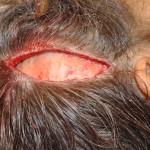The temporalis muscle is the largest and most powerful muscle of the face and skull. It runs from almost to the back of the head down below and behind the cheek bone to attach to the lower jaw. It can be seen to have two parts. The anterior or front part runs almost vertically and moves the lower jaw forward (protrudes the lower jaw). The posterior part of the muscle above the ear runs almost horizontally and pull the lower jaw backwards. If both parts of the muscle are activated, it causes one to bite down. This is the classic functional and anatomic description given to the temporalis muscle seen in any anatomy textbook or article.
It is the posterior part of the muscle that has aesthetic relevance as it relates to the perceived width of the head above the ears. The posterior temporalis muscle in this area can be surprisingly thick, often 5 to 7mms in thickness. (in not more in some men) Reducing or removing the posterior temporalis muscle can make a very noticeable change in head width, bringing in the sides above the ears considerably. While this is an aesthetic benefit, it would seem that removal of the posterior part of the muscle would cause problems with bringing in the lower jaw during closure. (per anatomic descriptions as previously noted)

Aesthetic temporal reduction by muscle removal (myectomy) is a safe and effective procedure. Despite what one would anatomically expect and is written, the posterior segment of the temporalis muscle can be completely removed without causing any dysfunction of jaw movement.
Dr. Barry Eppley
Indianapolis, Indiana


